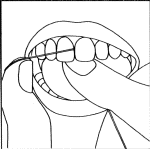|
How do I prevent
cavities?
You can help prevent cavities by following
these tips:
- Brush
twice a day with a fluoride toothpaste.
- Floss
daily or use an interdental cleaner.
- Eat nutritious and balanced meals and
limit snacking.
- Check with your dentist about use of
supplemental fluoride, which strengthens your teeth,
and about use of dental
sealants (a plastic protective coating)
applied to the chewing surfaces of the back teeth to
protect them from decay.
Visit
your dentist regularly for professional cleanings and
oral examination
How should I choose oral
care products

Even savvy shoppers can be baffled by
the seemingly endless variety of dental care products.
Oral care products that may carry the ADA Seal include
toothpaste, manual and electric toothbrushes, floss and
other interdental cleaning aids, mouthrinses and oral
irrigators.
top
how often should I
replace my toothbrush?
Treat yourself to a new toothbrush every
three to four months, or sooner if the bristles become
worn, splayed or frayed. A hard, brittle brush can injure
your gums. Children's brushes may need to be replaced more
often, as they can wear them out more quickly.
Does it matter what kind
of toothbrush I use?
Yes. Choosing the right toothbrush can help
prevent damage to your teeth and gums. Use an ADA-accepted
toothbrush that has polished bristles, as they are less
likely to injure gum tissue. Also use a size and shape
that feels comfortable and allows you to reach the
surfaces of every tooth. Replace your brush if the
bristles become worn, splayed or frayed. A hard, brittle
brush can injure your gums. Because children often chew on
their brushes, they can become worn out more quickly.
top
What is the proper way
to brush my teeth?
Thorough brushing twice a day, and cleaning
between the teeth daily with floss or other interdental
cleaners, remove plaque. Keep these tips in mind when
brushing your teeth. Use a soft-bristled toothbrush. Place
the brush at a 45-degree angle to the teeth and use a
gentle tooth-wide, back-and-forth motion. Remember to
clean the inside teeth surfaces where plaque deposits are
heavy, and clean the back teeth and tongue. Replace your
brush when the bristles become frayed or worn ó about
every three to four months.
Can I damage my teeth if I brush improperly?
Yes. Even though teeth are protected by a hard layer
of enamel, they can become worn out from improper
toothbrushing. Toothbrush abrasion can occur on the
crown of the teeth as well as in the softer cementum
that covers the tooth roots, which can be exposed by
receding gums. These exposed surfaces can become more
prone to decay. When you brush, be sure to use gentle,
short, tooth-wide strokes.
How do I clean between teeth?

- Floss and other interdental cleaners remove plaque
from between the teeth and under the gumline, areas
where the toothbrush can't reach. If you haven't been
in the habit, it's never too late to start.
- When flossing, keep in mind these tips. Gently ease
the floss between the teeth and gumline, never snap
it. Form a "c" against the sides of both
teeth and gently rub the floss up and down the tooth,
moving it from under the gumline to the top of the
tooth. Establish a regular pattern of flossing and
remember to floss the backside of the last teeth.
- If you use interdental cleaners, ask your dentist
how to use them properly, to avoid injuring your gums.
top
What are oral irrigating devices?
Oral irrigating devices use a stream of water to
remove food particles from around the teeth. They are
meant to be used as an aid and not to replace regular
brushing or cleaning between the teeth with floss or
interdental cleaners. Oral irrigators are helpful for
people who have braces or fixed partial dentures.
top
If I install a water filter, will it remove
fluoride from the water?

Depending upon the filtration system that you use at
home, journal articles have reported that reverse
osmosis and distillation filtration units do remove
varying amounts of fluoride from the water. Activated
carbon units were shown to remove only trace amounts.
Several tests of water filters, however, have shown
conflicting answers. Consult with your family dentist
about your family's fluoride needs.
top
How
often should I get a new toothbrush?
Every 3-4 months or whenever the edges get frayed.
top
What
is the best way to brush my teeth?
Small circular motions around all surfaces of the teeth.
You should hold your toothbrush at a 45-degree angle to your gums.
You should brush for a minimum of three full minutes. Brushing too
hard or too often can cause gum problems.
top
How
important is flossing?
Flossing is an integral part of good oral hygiene. Food
gets trapped between teeth, and the toothbrush canít remove it.
Over time, this can lead to cavities and bad breath. Improper
flossing techniques can cause damage to your gums. Consult your
dentist about good flossing habits.
top
|